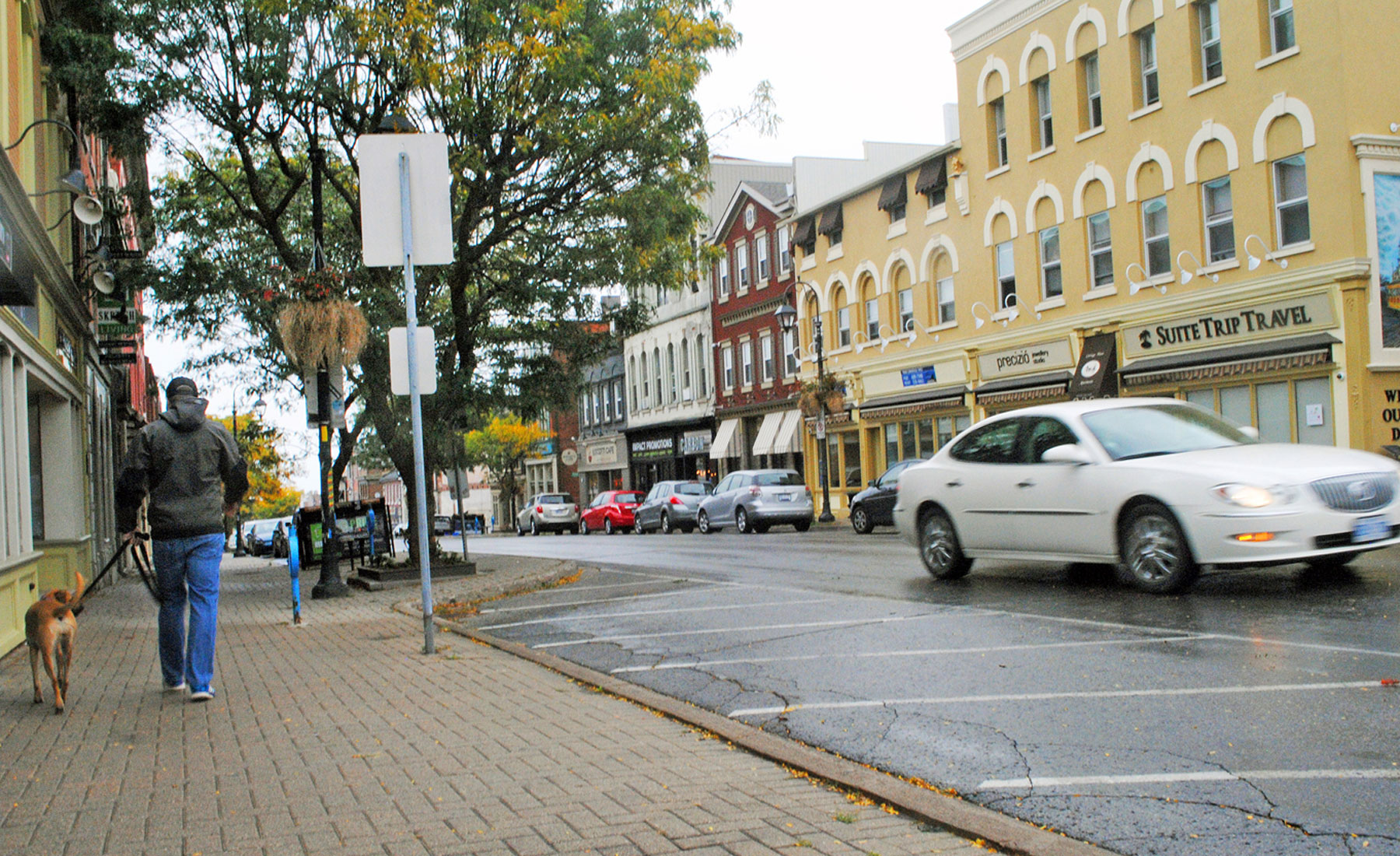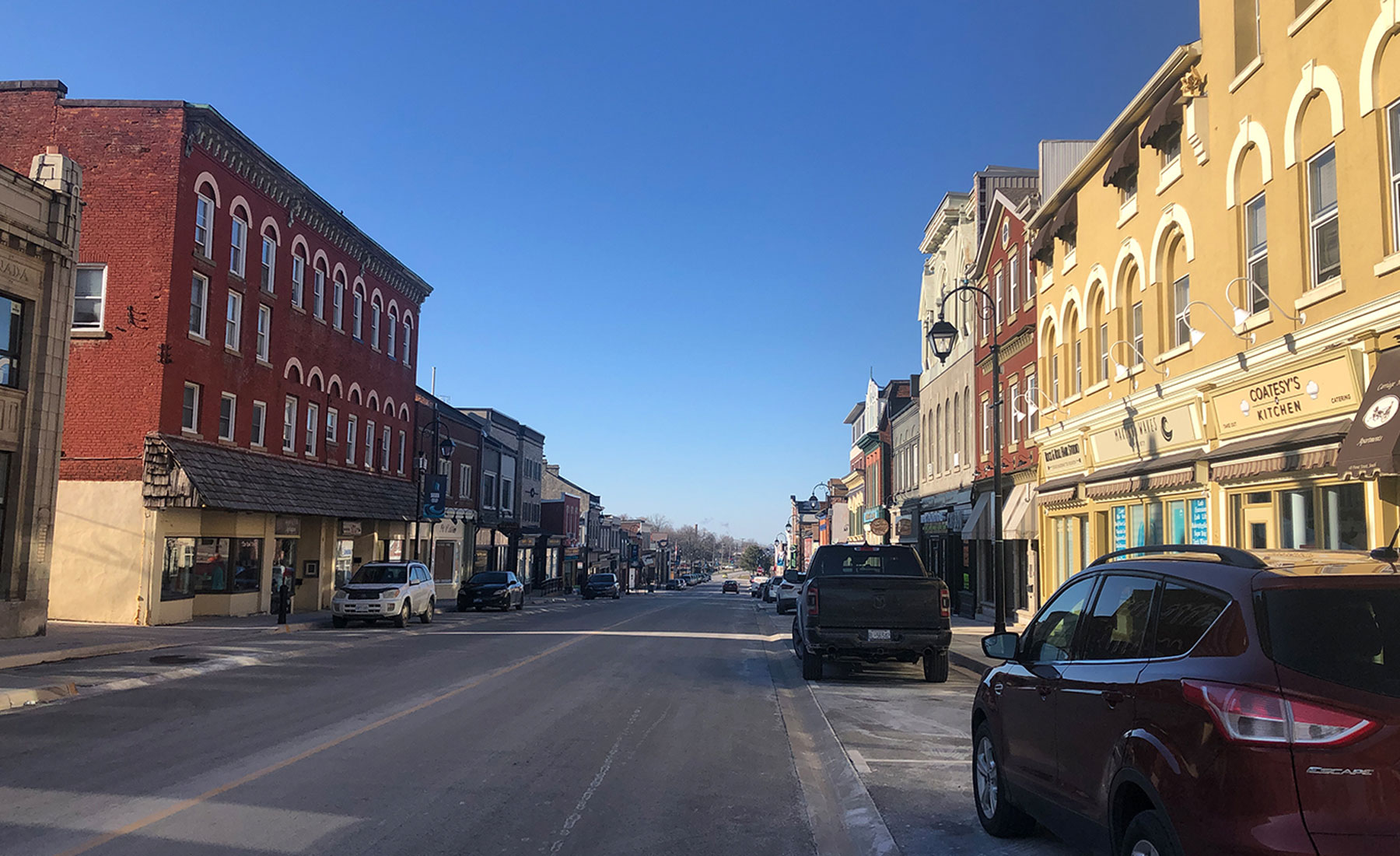Two contrasting views of Front Street in downtown Thorold: before the revitalization project (on left) and afterwards (right). Photo of Front Street before the revitalization project taken by Paul Forsyth, provided courtesy of NiagaraThisWeek.com; after photo by Christine Daigle.
New urban development sites have proliferated in recent years.
The housing market in Canada is feverish, with many claiming that more housing needs to be built in order to satisfy the increasing demand. This will mean increased urban expansion and the conversion of land into brand-new neighbourhoods filled with cookie-cutter houses. Young trees will be planted here-and-there to grow through sidewalks. Conversely, sidewalks may sometimes be nonexistent in certain neighbourhoods that are poorly serviced by public transit. These areas will be designed with the assumption that residents will use cars to commute, with little thought given to the walkability of the neighbourhood.
Urban developers who design these neighbourhoods may also plan for a green space or playground, especially when the area is meant to be family-oriented. Yards will be covered with roll-out grass to create instant lawns, with empty spaces left for the first dwellers to garden as they wish—or not. Plants that were naturally growing in these areas (in harmonious relation with the animals and bugs of the surrounding ecosystem), will become seen as “weeds” that need to be controlled and eliminated.
What was once a natural habitat, with a variety of animal and plant species that all shared an ecosystem, will be destroyed. In its place will be a space designed by humans, and for humans, with the goal of eliminating as many “natural annoyances” as possible.
Land clearing makes space for humans — while simultaneously eliminating entire ecosystems in the process. Furthermore, it brings humans and wildlife closer together, often with negative implications. Increased urban sprawl in Thorold has generated a surge of coyote encounters and even attacks. Closer proximity between animals and humans can also increase incidences of zoonotic diseases, such as bird flu or rabies.
While there has been lot of work done in relation to sustainable urban development, it often focuses on mitigating the impact of climate change by planning for human movement that is not car-dependent, through the development of more efficient public transit, cycling and walking paths. But more should also be done to work with established ecosystems — instead of clearing and destroying them. The United Nations Environment Programme (UNEP) report, “Integrating the Environment in Urban Planning and Management. Key Principles and Approaches for Cities in the 21st Century,” for example, proposes a series of planning principles for integrated and sustainable urban development. This includes committing to an environmental ethic and the regeneration of natural systems in order to make cities green.
Those principles, along with care for existing ecosystems, are unfortunately not always applied in real-world scenarios. A recent example of this can be seen in the Niagara region with the revitalization of Thorold’s downtown core. In recent years, a great deal of effort has gone into giving Thorold’s Front Street a facelift to attract new visitors, diners, and shoppers. Façades of buildings on the downtown street were redone and, as part of its recent push for revitalization in 2020, the city re-did the sidewalks, added parking spaces, and integrated benches, new light standards, and other streetscaping elements. Instead of implementing a design that kept the mature, established trees that adorned the street intact, the City opted to cut those trees down in order to facilitate new sidewalks. New, very young, trees were planted in their stead. While the change in landscape is indeed shocking, there is more than mere aesthetic enjoyment at stake here.
Comparing the old to the new, the pre-revitalization to the revitalized downtown core, one might notice that nature has been almost completely evacuated. The little, new trees that were recently planted have been given only a small space in the ground to expand their trunks. This will lead to the “necessity” of eventually cutting them down in the future—a necessity created entirely by humans’ lack of planning for the tree’s needs. Beyond the drastic change in canopy, one needs to also think of how the changes impact the many creatures that were living in, or relied on, the mature trees for survival. Cutting mature trees down to satisfy the human desire for revitalization destroyed the habitat of creatures that were forced to relocate. Revitalizing the downtown core was not done with a view of the ecosystem that it was and in fact amounted to a devitalization: where mature tree dwellers, such as birds, squirrels and bugs had to leave the downtown core, making it less lively. If planners had considered the impact on nature and ecosystems, they would—and could—have done things differently.
Making cities “green” and environmentally friendly by planning urban development with sustainability and respect for the integrity of ecosystems in mind is possible. It can — and it should— be at the forefront of our thinking as we continue building more space for human use.


